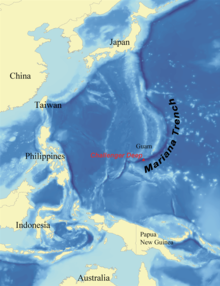WHOI sub Nereus explores deepest area of Pacific Ocean
Thursday, June 4, 2009
A Woods Hole Oceanographic Institution (WHOI) remotely operated vehicle touched down 10,902 meters (35,767 feet) in the Mariana Trench near the island of Guam.

Image: Kmusser.
On Sunday, May 31, Nereus dove into the Pacific Ocean and began its descent into Challenger Deep the deepest area of the Mariana Trench.
"It's the deepest known part of the ocean. The trench is virtually unexplored, and I am absolutely certain Nereus will enable new discoveries," said Andy Bowen, project manager of WHOI, "Reaching such extreme depths is the pinnacle of technical challenges. The team is pleased that Nereus has been successful in reaching the very bottom of the ocean to return imagery and samples from such a hostile world. With a robot like Nereus we can now explore anywhere in the ocean. The trenches are virtually unexplored, and Nereus will enable new discoveries there. Nereus marks the start of a new era in ocean exploration."
However, this is not the first time that a mission was sent into the trench. In 1998, the Japanese robot Kaiko was launched. In 1960 a two man bathyscaphe vehicle, the Trieste descended 10,916 meters (35,813 feet) to the ocean floor.
Nereus can be operated remotely or it can run as an autonomous underwater vehicle AUV. It is currently attached to the mother ship via an optic tether the diameter of a human hair.
"Much of the ocean's depths remain unexplored. Ocean scientists now have a unique tool to gather images, data and samples from everywhere in the oceans, rather than those parts shallower than 6,500 meters (4 miles). With its innovative technology, Nereus allows us to study and understand previously inaccessible ocean regions," said Julie Morris, director of the National Science Foundation (NSF)'s Division of Ocean Sciences. NSF assisted with the US$8 million project funding.
Nereus will send videos and collect samples on the ocean floor at the trench's subduction zone and area during its mission.
"The samples collected by the vehicle include sediment from the tectonic plates that meet at the trench and, for the first time, rocks from deep exposures of the Earth's crust close to mantle depths south of the Challenger Deep. We will know the full story once shore-based analyses are completed back in the laboratory this summer. We can integrate them with the new mapping data to tell a story of plate collision in greater detail than ever before accomplished in the world's oceans," said geologist Patty Fryer of the University of Hawaii.
Sources
- "Unmanned sub touches deepest part of world's ocean Explores Mariana Trench, more than 10 kilometres below surface of Pacific Ocean" — CBC News, June 3, 2009
- "Robot sub reaches deepest ocean" — BBC News, June 3, 2009
- "The Abyss: Deepest Part of the Oceans No Longer Hidden" — PhysOrg.com, June 3, 2009


